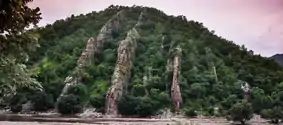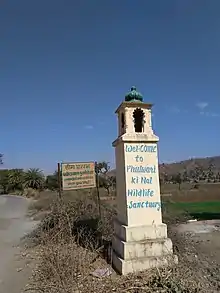Phulwari ki Nal Wildlife Sanctuary
Phulwari ki Nal Wildlife Sanctuary is located in Udaipur District of Rajasthan, in the southern Aravalli Hills bordering the state of Gujarat, India.[1] It was declared a Wildlife Sanctuary on 6 October 1983, by the Government of Rajasthan.[2][3]
| Phulwari ki Nal Wildlife Sanctuary | |
|---|---|
 Phulwari ki Nal Wildlife Sanctuary | |
 Phulwari ki Nal Wildlife Sanctuary  Phulwari ki Nal Wildlife Sanctuary | |
| Location | Kotra tehsil and Jhadol tehsil, Udaipur district, Rajasthan, India |
| Nearest city | Udaipur, Rajasthan |
| Coordinates | 24°12′54″N 73°14′43″E |
| Area | 511.41 km2 (197.46 sq mi) |
| Established | 1983 |
| Governing body | Rajasthan State Forest Department |

Geography
The area of the Phulwari ki Nal Wildlife Sanctuary is 511.41 km2.,[4] of which 365.92 km2 is Reserved Forest and 145.49 km2 is Protected Forests.[5] The sanctuary is spread over Kotra and Jhadol tehsils of Udaipur district.[2] There are 134 villages present inside the sanctuary.[2] Elevation of the terrain within the sanctuary varies from 600–900 m above MSL.[6] The climate in the sanctuary is classified as semi-arid, with an annual rainfall of 730 mm.[5][6]
The Government of India published a draft notification on 31 August 2015 stating the intent to declare an area of up to 7.5 km from the outer boundaries of the sanctuary as an Eco-Sensitive Zone.[7] As of 26 March 2019, the draft notification had not been finalized.[8]
Wildlife
Wild animals observed in the Phulwari ki Nal Wildlife Sanctuary include large-tailed nightjar,[9] flying squirrel,[10] three-striped palm squirrel, Asian chameleons,[11] Indian star tortoise,[12] mouse deer,[13] four-horned antelope,[14] and panther.[15]
Facilities
The Phulwari ki Nal Wildlife Sanctuary is administered out of headquarters located in Kotra, Udaipur District, Rajasthan.[2] There are three rest houses located inside and around the sanctuary, at Mamer, Panarwa, and Kotra.[2]
References
- Sharma, B.K.; Kulshreshtha, Seema; Rahmani, Asad R. (2013). Faunal Heritage of Rajasthan, India: Conservation and Management of Vertebrates. Springer Science & Business Media. p. 37. ISBN 9783319013459.
- "Annual Plan of Operations for Phulwari-ki-Nal Wildlife Sanctuary For The Year 2007-2008" (PDF). Retrieved 4 March 2017.
- "Rajasthan State Notification F11 (1) Revenue / 8 / 83 dated 6 October 1983" (PDF). Retrieved 24 December 2017.
- Kankane, P.L. (2000). Status Survey of Chinkara and Desert Cat in Rajasthan (PDF). Calcutta: Zoological Survey of India. p. 45. ISBN 81-85874-30-1.
- "Assessment of Biodiversity in Phulwari-ki-Nal Wildlife Sanctuary: A Conservation Perspective" (PDF). Foundation for Ecological Security. 4 March 2017.
- Sharma, Satish Kumar (1996). "Amphibians of Phulwari Ki Nal Wildlife Sanctuary". Journal of the Bombay Natural History Society. 92: 271–272.
- Extraordinary Gazette of India of 31 August 2015. New Delhi: Government of India. 2015.
- "Status of ESZ Notifications". Ministry of Environment, Forest and climate Change. Retrieved 26 March 2019.
- Sangha, Harkirat Singh; Devarshi, Dhirendra (2010). "Large-Tailed Nightjar Capimulgus Macrarus in Phulwari-ki-Naal Wildlife Sanctuary, Udaipur District, Rajasthan". The Journal of the Bombay Natural History Society. 107 (2): 173–174.
- Koli, Vijay Kumar; Bhatnagar, Chhaya; Sharma, Satish Kumar (January–February 2013). "Distribution and Status of Indian Giant Flying Squirrel (Petaurista philippensis Elliot) in Rajasthan, India". National Academy Science Letters. 36: 27–33. doi:10.1007/s40009-012-0105-z. S2CID 86161494.
- Sharma, S.K. (1997). "Herpetofauna of Phulwari-ki-nal Wildlife Sanctuary, Rajasthan State" (PDF). Journal of the Bombay Natural History Society. 94: 573–575.
- D'Cruze, Neil; Mookherjee, Aniruddha; Vyas, Raju; Macdonald, David W; de Silva, Anslem (2018). "Geochelone elegans (Schoepff 1795) – Indian Star Tortoise, Star Tortoise" (PDF). Chelonian Research Monographs. No. 5.
- Ecological Profile Gogunda, Rajasthan (PDF). Foundation for Ecological Security. 2017. p. 28.
- Meghwal, Ramchandra; Bhatnagar, Chhaya; Koli, Vijay Kumar (2018). "Activity and social behaviour of four-horned antelope (Tetracerus quadricornis de Blainville, 1816) in tropical deciduous forests of Aravalli mountain range, Western India". Folia Zoologica. 67: 22–31. doi:10.25225/fozo.v67.i1.a4.2018. S2CID 90877884.
- Mathur, Ashok (7 February 2018). "Panthers are entering cities. Question is whether to kill or save them?". Udaipurblog.com. Retrieved 10 June 2018.
Further reading
- Banu, Farhat; Sharma, Satish Kumar (2016). "A Note on Bryophytic Flora of Certain 'Nals' of Phulwari Wildlife Sanctuary" (PDF). Indian Journal of Environmental Sciences. 20 (1&2): 53–57. Retrieved 10 June 2018.